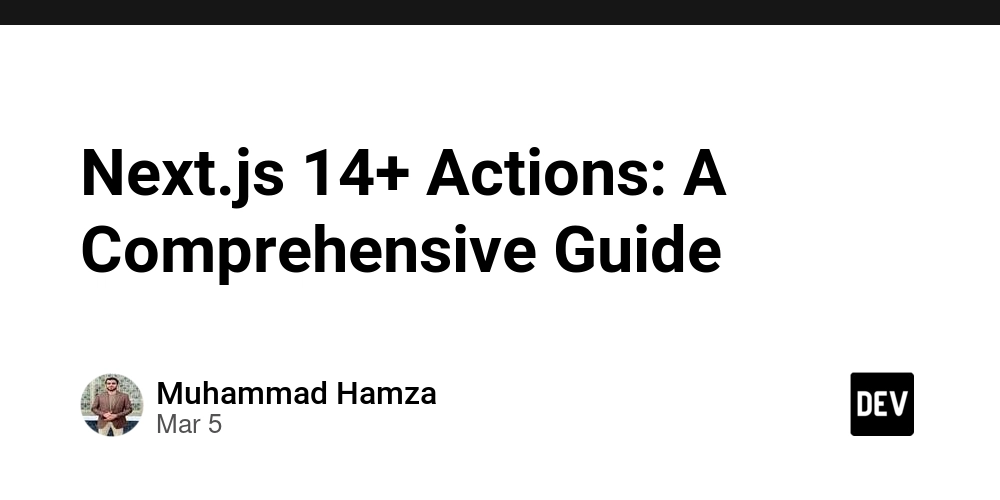Next.js 14+ Actions: A Comprehensive Guide
What are Next.js Actions? Next.js Actions are a powerful feature introduced in version 14 that simplify server-side and client-side data mutations and form handling. They provide a streamlined way to handle form submissions, data updates, and server-side operations directly within your React components. Key Characteristics of Next.js Actions Server-Side Execution Actions can be defined on the server and called directly from the client They run on the server by default, ensuring security and performance Automatically handle data transformations and validations Simplified Form Handling Eliminate the need for complex API route configurations Provide built-in support for form submissions Seamlessly integrate with React Server Components Basic Action Implementation // app/actions.ts 'use server'; // Marks the file for server-side actions export async function createUser(formData: FormData) { const name = formData.get('name'); const email = formData.get('email'); // Perform server-side logic try { // Example: Save user to database await saveUserToDatabase(name, email); return { success: true, message: 'User created successfully' }; } catch (error) { return { success: false, message: 'Failed to create user' }; } } Using Actions in React Components // app/page.tsx import { createUser } from './actions'; export default function UserForm() { return ( Create User ); } Advanced Action Features Progressive Enhancement Works without JavaScript enabled Provides fallback mechanisms for form submissions Improves overall application accessibility Type Safety Supports TypeScript for robust type checking Enables compile-time validation of action parameters Error Handling Built-in error propagation Allows granular error management Supports both client-side and server-side error handling Best Practices Keep actions focused on single responsibilities Use server directives ('use server') to mark action files Implement proper validation and error handling Consider performance implications of server-side operations Leverage TypeScript for type safety Limitations and Considerations Requires Next.js 14 or later Server actions are not suitable for all types of mutations Complex workflows might need custom API routes Performance overhead for very frequent or complex operations When to Use Actions Form submissions User registration Data updates Simple CRUD operations Server-side validations Centralized mutation logic When to Avoid Actions Complex, multi-step workflows Extensive data transformations High-frequency updates Operations requiring multiple database interactions Scenarios needing more granular control

What are Next.js Actions?
Next.js Actions are a powerful feature introduced in version 14 that simplify server-side and client-side data mutations and form handling. They provide a streamlined way to handle form submissions, data updates, and server-side operations directly within your React components.
Key Characteristics of Next.js Actions
-
Server-Side Execution
- Actions can be defined on the server and called directly from the client
- They run on the server by default, ensuring security and performance
- Automatically handle data transformations and validations
-
Simplified Form Handling
- Eliminate the need for complex API route configurations
- Provide built-in support for form submissions
- Seamlessly integrate with React Server Components
Basic Action Implementation
// app/actions.ts
'use server'; // Marks the file for server-side actions
export async function createUser(formData: FormData) {
const name = formData.get('name');
const email = formData.get('email');
// Perform server-side logic
try {
// Example: Save user to database
await saveUserToDatabase(name, email);
return { success: true, message: 'User created successfully' };
} catch (error) {
return { success: false, message: 'Failed to create user' };
}
}
Using Actions in React Components
// app/page.tsx
import { createUser } from './actions';
export default function UserForm() {
return (
<form action={createUser}>
<input type="text" name="name" required />
<input type="email" name="email" required />
<button type="submit">Create User</button>
</form>
);
}
Advanced Action Features
-
Progressive Enhancement
- Works without JavaScript enabled
- Provides fallback mechanisms for form submissions
- Improves overall application accessibility
-
Type Safety
- Supports TypeScript for robust type checking
- Enables compile-time validation of action parameters
-
Error Handling
- Built-in error propagation
- Allows granular error management
- Supports both client-side and server-side error handling
Best Practices
- Keep actions focused on single responsibilities
- Use server directives (
'use server') to mark action files - Implement proper validation and error handling
- Consider performance implications of server-side operations
- Leverage TypeScript for type safety
Limitations and Considerations
- Requires Next.js 14 or later
- Server actions are not suitable for all types of mutations
- Complex workflows might need custom API routes
- Performance overhead for very frequent or complex operations
When to Use Actions
- Form submissions
- User registration
- Data updates
- Simple CRUD operations
- Server-side validations
- Centralized mutation logic
When to Avoid Actions
- Complex, multi-step workflows
- Extensive data transformations
- High-frequency updates
- Operations requiring multiple database interactions
- Scenarios needing more granular control







































































